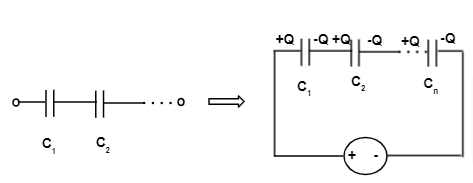Capacitors in Series Calculator
Capacitors in Series Calculator will help you find the equivalent capacitance value of individual capacitors. All you need to do is simply enter the capacitors values and click on the calculate button to avail total capacitance in no time.
Adding Capacitors in Series | Series Capacitance Formula
Capacitor is an electric component in which electric charge is stored. We can arrange capacitors either in series or parallel based on the future application. If they are combined in series, the charge Q in each capacitor is same.
Consider capacitors connected in series without any source of voltage. One of the simplest ways to visualize this is to use the parallel plate capacitors and its works for both cylindrical and spherical ones. In this case each element will not store any charge and we apply a voltage at the end of the circuit.

Check the first capacitor connected in the circuit, since electrons move towards the power source one part of the capacitor becomes positively charged. In Case of Equilibriul this value is +Q. Basic concept in capacitors is that they will have charge stored on both plates is same and have opposite signs. At the second end of the element they will have a charge -Q. Charge comes from neighboring capacitor instead from the voltage source instead.
Assume the box as a black box where the charge leaves power source from one end goes through box and comes from the other side. Here overall charge is conserved and thus input and outpit values need to be equivalent. Voltage of Capacitors V is the sum of voltages of each one individually i.e. (VΓéü, VΓéé, ...). Rearrnging the basic formula of capacitance we can get the voltge across whole circuit i.e. V = Q / C and for each one we can write it as VΓéü = Q / CΓéü, VΓéé = Q / CΓéé and so on.
Adding Capacitors in Series is nothing but the summation of volatges i.e. V = VΓéü + VΓéé + ... → Q / C = Q / CΓéü + Q / CΓéé + ....
Dividing with Q on both the sides we get the final equation for capacitance as 1 / C = 1 / CΓéü + 1 / CΓéé + .... . In other words, we can frame the sentence as inverse of total capacity is the sum of inverse of individual capacitances.
Series Capacitance Examples
Example
Find the Total Capacitance of 220nF Capacitor and 345nF Capacitors connected in Series?
Solution:
Given that
First Capacitor's Capacitance CΓéü = 220nF
Second Capacitor's Capacitance CΓéé = 345nF
We know the formula to calculate Series Capacitance 1 / C = 1 / CΓéü + 1 / CΓéé + ....
Substituting the known parameters in the above equation we get 1 / C = 1 / 220nF + 1 / 345nF
Simplifyig further we get the value of capacitance C = 134.336nF
Therefore, the total capacitance is 134.336nF
Physicscalc.Com has got concepts like friction, acceleration due to gravity, water pressure, gravity, and many more along with their relevant calculators all one under one roof.
FAQs on Capacitors in Series Calculator
1. What happens when Capacitors are Connected in Series?
If Capacitors are Connected in Series then total capacitance is less than any one of the series connected individual capacitances.
2. Why would you put capacitors in series?
You can connect capacitors in series in order to increase their overall effective circuit voltage handling capacity.
3. Is Charge Constant across Capacitors in Series?
Capacitors in Series will have same amount of current flowing through them and so is the charge on the plates irrespective of their capacitances.
4. What is the Capacitance Formula for Capacitors in Series?
Capacitance Formula for Capacitors in Series is given by 1 / C = 1 / CΓéü + 1 / CΓéé + ....
